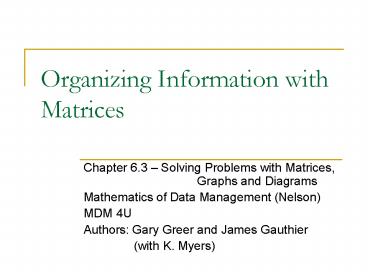Organizing Information with Matrices PowerPoint PPT Presentation
1 / 23
Title: Organizing Information with Matrices
1
Organizing Information with Matrices
- Chapter 6.3 Solving Problems with Matrices,
Graphs and Diagrams - Mathematics of Data Management (Nelson)
- MDM 4U
- Authors Gary Greer and James Gauthier
- (with K. Myers)
2
Definition
- according to our textbook, a matrix is a
rectangular array of numbers set out in rows and
columns. - other definitions include
- biological matrix
- geological matrix
- fictional (?) virtual reality network
- 1970s British sci-fi television (e.g., The
Deadly Assassin) - William Gibsons novels (e.g., Neuromancer)
- recent films by the Wachowski Brothers
3
The Dimensions of a Matrix
- In general, if a matrix A has m rows and n
columns, it is called an m-by-n matrix. - The variables m and n represent the dimensions of
the matrix. - In other words, the dimensions of a matrix
correspond to the number of rows and columns in
the matrix. - The entry, a, in row i and column j is
represented as aij
4
Example
- A is a 3 x 3 matrix (i.e., m 3 and n 3)
5
General Example
- A is an m x n matrix
- Note that the location scheme is like the
Battleship Game
6
Row and Column Operations
- The row sum of a matrix is the sum of the
elements in a single row of a matrix. - Similarly, the column sum of a matrix is the sum
of the elements in a single column of a matrix. - See pp. 348 349 of the text for an example that
calculates the row sum and the column sum of a
matrix.
7
Example of row and column sums
- The sum of the first row is 11
- The sum of the second row is 31
- The sum of the first column is 12
- The sum of the second column is 20
8
Multiplication of a Matrix by a Scalar
- In physics, a scalar is a quantity with magnitude
but no direction. - In terms of Chapter 6, we can think of a scalar
as an individual number outside a matrix. - When a matrix is multiplied by a scalar, the
operations are simple - each entry in the matrix is multiplied by the
scalar.
9
Example Scalar-Matrix Multiplication
10
Addition and Subtraction of Matrices
- Addition and subtraction of matrices is only
defined when the matrices involved are of equal
dimension. - Two matrices, A and B, may be added together by
adding the corresponding entries in each matrix.
11
Addition...
12
Subtraction...
13
General form
- If matrix A and matrix B have the same
dimensions, then... - The sum S A B is the matrix formed by adding
the entries of matrix A to the corresponding
entries of matrix B, where - sij aij bij
- The difference matrix D A B is formed by
subtracting the entries of matrix B from the
corresponding entries of matrix A, where - dij aij bij
14
Exercises / Homework
- Homework
- page 353, 1, 2
- page 354, 6
- page 355, 8a
- Also... examine the web links in this
presentation
15
Matrix Multiplication
- Chapter 6.4 Solving Problems with Matrices,
Graphs and Diagrams - Mathematics of Data Management (Nelson)
- MDM 4U
- Authors Gary Greer and James Gauthier
- (with K. Myers)
16
Product of Two Matrices C AB
- The product, C, of matrix A and matrix B is
defined only if A is an (m x k) matrix and B is a
(k x n) matrix. - In this case, C will be an (m x n) matrix.
- This means in order for C to be defined, the
number of columns of A has to be equal to the
number of rows of B. - So, we may multiply A2x3 and B3x4 to produce C2x4
We cannot multiply A2x3 and B4x3
17
Example Row times Column
- Lets start by multiplying a row matrix and a
column matrix with the same number of entries. - m 1 and n 1 (i.e., A1xk times Bkx1)
- The result will be a single number (which, if one
insists that the product of two matrices always
must be a matrix, may be viewed as a 1x1 matrix). - The element of the i-th row and the j-th column
of the product is found by multiplying the i-th
row of A by the j-th column of B.
18
Example (continued)
19
Now... A2x4 times B4x3
2102444
3122748
182140
5244980
10305688
15366396
70
80
90
158
184
210
20
Matrix Multiplication (more)
- Given two matrices A and B, where A is an (m x k)
matrix and B in a (k x n) matrix... - The inner product is the number that results from
the sum of the products of each row entry from
matrix A with its corresponding column entry from
matrix B. - Therefore, if C AB, each entry in matrix C is
the inner product of a row from matrix A and the
corresponding column from matrix B.
21
Transition Matrices
- A transition matrix is used to represent the
number of edges that connect the vertices of a
directed graph. - Transition matrices may be used to represent
paths through a maze, predator-prey relationships
or any other interrelationship that can be
represented by a digraph. - If T is a transition matrix for a digraph, then
Tn shows all paths of length n between the
vertices of the graph.
22
Example Building A Transition Matrix
23
Exercises / Homework
- Read the examples
- pages 360 368
- Exercises
- page 369, 1, 2, 4
- page 370, 8, 9, 10
- page 372, 14

